 Co-Creating Change by Jon Frederickson is a book I read on accident after Amazon suggested it and I failed notice the author was not ‘Ron Frederick’, the author of Living Like You Mean It. Mistaken as I may have been, it was serendipity that the book fell into my lap. Living Like You Mean It was a perspective shifting book, but it was fluffy and full of euphemisms to shield our gentle psyches from the full and difficult task of understanding ourselves and regulating our expressions.
Co-Creating Change by Jon Frederickson is a book I read on accident after Amazon suggested it and I failed notice the author was not ‘Ron Frederick’, the author of Living Like You Mean It. Mistaken as I may have been, it was serendipity that the book fell into my lap. Living Like You Mean It was a perspective shifting book, but it was fluffy and full of euphemisms to shield our gentle psyches from the full and difficult task of understanding ourselves and regulating our expressions.
Co-Creating Change, doesn’t euphemize because it’s a book for practitioners of cognitive behavioral therapy. It’s focus is supporting a third party with tools to help a patient understand what ails them.
Books that look at the mechanical elements of psychology fascinate and inspire me. Through various books, time spent in my head, conversations, and a relationship with a good therapist, I’ve come to appreciate the benefits of intentionally distinguishing my emotional experience from my analytical one. With some growing understanding of the science of psychology, surmounting my own problems has become less bewildering. As apparently brash as it gets (for the layperson or individual), it’s why I love this book. It helps the examiner understand the mechanism for understanding. This book delves into basic moving emotional parts that most people have in common and some of the broad ways that those moving parts can affect people in negative ways.
Those moving emotional parts make up what is called ‘The Triangle of Conflict”. Most people tend to think of their circumstances as making them happy or unhappy, but it’s usually not the case. In the triangle of conflict, a person has some feeling (say, anger), but because of their experiences during development, having this feeling gives them anxiety. Then, rather than having the feeling and letting it run its course, they use defenses to deal with the symptoms of the anxiety. It’s the defenses against anxiety that cause people’s problems. According to Frederickson, among the therapist’s most important tasks is helping the patient see the triangle of conflict.
People are unique, but not that unique. We all have feelings, we’re just differently aware of them. When someone punches you in the face, it’s normal to feel angry. When you receive a gift, it’s normal to feel happy. When your significant other breaks up with you, it’s normal to feel sad. Yet in many of those situations, people will swear up and down that they’re not angry, happy, sad or whatever. In as much as people try to not have feelings, those feelings exist and if they’re not felt, they’ll be channeled elsewhere. Usually into anxiety.
The emotion of fear is defined as when our body is activated by our nervous system in response to a perceived threat (e.g., heart pounding, sweaty palms). Anxiety is when those feelings come into our awareness, which is an unpleasant experience, and so we respond to that experience with conscious and unconscious defenses.
Defenses are the methods we use to ward off anxiety. For example, someone who just lost their job might use a cover word and say they are “upset” rather than “angry”, in order to avoid the anxiety they feel when they get angry. Or they might instead use a “generalization” defense, and speak in very general terms. Or they might speak, or think very fast. The list of defenses is long, and capped with some pretty pathological examples, but they all seem to work about the same way in the triangle of conflict.
There are benefits to seeing yourself as a collection of clues. Our anxiety in one place, might indicate feelings in another. Tracing the triangle of conflict can reveal the source of feelings and the opportunity to choose different methods for expressing them, which is what this is really about: Being able to make different choices. We perplex ourselves with resolute defiance of some habit, only to land back in the scuffle before the dust can even settle. The solution to anyone’s problem is almost always “make different choices”. That part is easy, and we usually know what those choices should be. The tricky part is how to actually make those choices.
This book is not in any way a self-help book. In fact, the title kind of rules that out. But it’s also pretty intense in general. The final chapters go through an emotional process with a few vignetted patients which would border on dark and disturbing for some people. I can only speak for myself in saying that I found this book fascinating and a useful tool for my own private inquiry. If you’re a layperson or therapist, you’ll probably find it helpful, if not a good refresher.

Recent Discussion